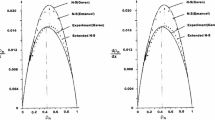Abstract
The transient two-fluid model has been used to develop a general relation for acoustic waves. The analysis is valid in principle over the whole void fraction region. Flow pattern transitions from one flow regime to the other are assumed to occur at certain void fractions. Different correlations are used to calculate the interfacial area and interfacial drag force per unit mixture volume for bubbly flow, slug flow and annular flow respectively. The vapour-liquid interphase heat flux is derived from the one dimensional Fourier heat conduction equation to evaluate the interphase evaporation or condensation rate.
Based on the present theory, a program has been carried out. Calculations are performed for pressure from 0.07 MPa to 16.0 MPa, void fractions from 0.0 to 1.0. The predicted sound speeds are compared with some experimental data for low pressures, good agreement has been achieved between sound speed predictions and experimental data.
Similar content being viewed by others
References
F.J. moody, “A pressure Pulse Model for Two-Phase Critical Flow and Sonic Velocity,”J. of Heat Transfer, Trans. ASME, pp. 371–384, (1969).
D.F. Darcy, “On Acoustic Propagation and Critical Mass Flux in Two-Phase Flow,”J. of Heat Transfer, Trans. ASME, pp. 413–421, (1971).
R.C. Mecredy & L.J. Hamilton, “The Effects of Nonequilibrium Heat, Mass and Momentum Transfer on Two-phase Sound Speed,”Int. J. Heat Mass Transfer,15, pp. 61–72, (1972).
L.Y. Cheng, D.A. Drew, R.T. Lahey, Jr., “An Analysis of Wave Propagation in Bubbly Two-Component, Two-phase Flow,”J. of Heat Transfer, Trans. ASME,107, pp. 402–408, (1985).
A.E. Ruggles, R.T. Lahey, Jr., D. A. Drew & H.A. Scarton, “An Investigation of the Propagation of Pressure Perturbations in Bubbly Air/Water Flows,”J. of Heat Transfer, Trans. ASME,110, pp. 494–499, (1988).
A.E. Ruggles, R.T. Lahey, Jr., D.A. Drew & H.A. Scarton, “The Relationship between Standing Waves, Pressure Pulse Propagation, and Critical Flow Rate in Two-Phase Mixtures,”J. of Heat Transfer, Trans. ASME,111. pp.467–473, (1989).
Chung NienNien, Liu Weikeng, Pei BauShei, “A Model for Sound Velocity in a Two-Phase Air-Water Bubbly Flow,”Nuclear Technology,99, pp. 80–89, (1992).
Chung NienNien, Liu Weikeng, Pei BauShei, “A Model for Sound Velocity and its Relationship with Interfacial Area in a Steam-Water, Two-Phase Bubbly Flow,Nuclear Technology,99, pp.258–267, (1992).
Victor J. Dejon & Josephc. Firey, “Effect of Slip and Phase Change on Sound Velocity in Steam-Water Mixtures and the Relation to Critical Flow,”I & EC Process and Development,7, No.3, pp.455–463, (1968).
W.G. England, J.G. Firey & D.E. Trapp, “Additional Velocity of Sound Measurements in Wet Steam,”I & EC Process and Development,”5, No.2, pp. 199–202, (1966).
J. Weisman, T. Ake & R. Knott, “Two-Phase Pressure-Drop Across Abrupt Area Changes in Oscillatory Flow,”Nuclear Science & Engineering,61, pp. 297–309, (1966).
Rivkin, Aleksandrov & Kremenevskaya, «Thermodynamic Derivations for Water and Steam», McGraw-Hill, New York, (1987).
Wallis, «One-Dimensional Two-Phase Flow», McGraw-Hill, New York, (1969).
P. Griffith, G. A. Synder, “The Bubbly-Slug Transition in a High Velocity Two-Phase Flow,” MIT Report 5003-29, (1964).
P. Griffith, G.B. Wallis, “Two-phase Slug Flow,” J. of Heat Transfer, Trans. ASME,83, p.307, (1961).
K.H. Ardon, R.B. Duffey, “Acoustic Wave Propagation in a Flowing Liquid-Vapor Mixtures,”Int. J. Multiphase Flow,4, pp.303–322, (1978).
R.E. Henry, M.A. Grolmes, H.K. Fauske, “Pressure Pulse Propagation in Two-Phase One and Two-Component Mixture,” Argonne National Laboratory Rep. 7792, (1971).
H.B. Karplus, “Propagation of a Pressure Wave in a Mixture of Water and Steam,” Armour Research Foundation of Illinois Institute of Technology Rep. 4132, (1961).
S. Kaizerman, E. Wacholder and E. Elias, “Characteristics Analysis of Inhomogeneous, Nonequilibrium, Two-Phase Flows Using the Drift-Flux Model,”Nucl. Sci. and Eng. 84, No.2, pp.168–173, (1983).
Author information
Authors and Affiliations
Additional information
This project was financed by National Natural Science Foundation of China and National Nuclear Safety Administration of China.
Rights and permissions
About this article
Cite this article
Xu, J., Chen, T. Acoustic wave prediction in flowing steam-water two-phase mixture. J. of Thermal Science 3, 147–154 (1994). https://doi.org/10.1007/BF02653114
Issue Date:
DOI: https://doi.org/10.1007/BF02653114




